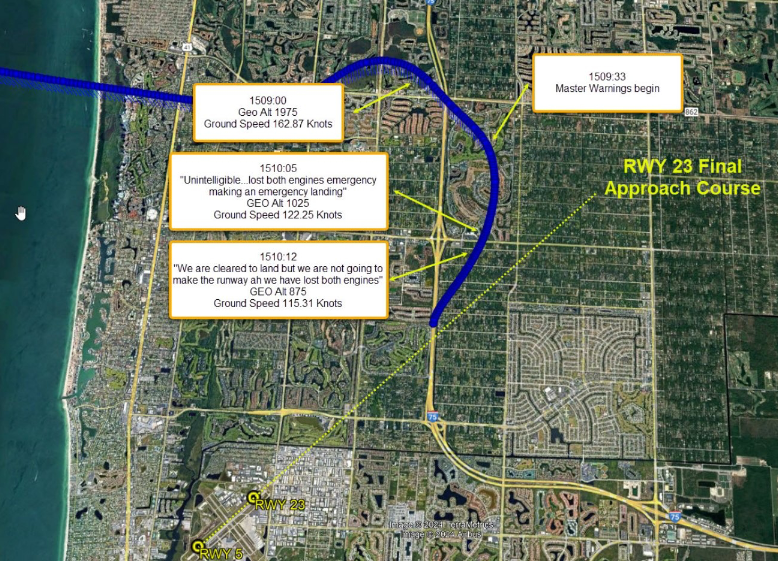NTSB has released a preliminary report on the Bombardier Challenger 600 crash near Naples, Florida.
The aircraft, identified as N823KD, incurred total destruction in the incident. Tragically, both pilots lost their lives, while the cabin attendant and two passengers sustained minor injuries. Additionally, one individual on the ground suffered minor injuries. The flight was operated by Ace Aviation Services, operating as Hop-A-Jet.
During the approach to APF airport, while maneuvering for a 5-mile final approach to runway 23, the flight crew established contact with the ATC tower. At approximately 15:08, the tower controller granted clearance for landing while the aircraft was positioned about 6.5 miles north of APF at an altitude of about 2,000 ft and a groundspeed of 166 knots, executing a turn for the base leg of the traffic pattern.
Three Master Warnings occurred successively, starting at 15:09:33 with “L ENGINE OIL PRESSURE,” followed immediately by “R ENGINE OIL PRESSURE” at 15:09:34, and then “ENGINE” at 15:09:40. These warnings were indicated by illumination of a “Master Warning” light, a corresponding red message on the crew alerting system page, and a triple chime voice advisory (“Engine oil“).
Approximately twenty seconds later, at 15:10:05, at an altitude of about 1,000 ft msl and a speed of 122 knots, the crew declared, “…lost both engines… emergency… making an emergency landing.” The tower controller acknowledged the call and cleared the aircraft to land. By 15:10:12, at around 900 ft and 115 knots, the crew communicated, “We are cleared to land but we are not going to make the runway… ah… we have lost both engines.“
Subsequently, no further transmissions were received from the flight crew, and the ADS-B track data concluded at 15:10:47, directly over Interstate 75 in Naples, Florida.

Dashcam footage captured the final moments of the flight, revealing the airplane’s descent into a shallow left turn before aligning its wings and touching down on Interstate 75’s southbound lanes. Initially, the left main landing gear made contact with the center lane, followed by the right main landing gear touching down in the right lane. Subsequently, the aircraft traversed the breakdown lane and grass shoulder before colliding with a concrete sound barrier. Dust, fire, smoke, and debris obscured the aircraft until the video concluded.
Following the aircraft’s halt, the cabin attendant, amid the fire blocking cabin and emergency exits, successfully guided herself and passengers to safety through the baggage compartment door in the tail section.
FAA and maintenance records indicate the airplane, outfitted with two GE CF34 Series turbofan engines, was manufactured in 2004 and underwent its most recent continuous airworthiness inspection on January 5, 2024, after accruing 9,763 total operational hours.
Examination of the accident site unveiled tire imprints on Interstate 75’s southbound lane, corresponding to the left main landing gear, with the aircraft coming to a stop approximately 1,000 feet beyond the initial touchdown point. Positioned upright amid the grass, facing north and opposite to the direction of travel, major components were present, amidst a fuel-soaked ground emitting a Jet-A fuel odor.
Key findings at the scene included the cockpit center console’s separation from the main wreckage, both engine throttle levers near the IDLE stop position, and the flap selector handle indicative of 45° flap extension.
Further inspection revealed significant post-impact fire damage to the left wing, with the flap actuator jack screws aligned with 45° flap extension. Notably, the left wing fuel boost pump was absent. The right wing exhibited leading edge damage consistent with a collision with a vertical steel I-beam of a highway sign, resulting in the front spar’s severance. While the outer wing segment was detached upon impact, the inner portion sustained thermal damage. The right wing fuel boost pump, discovered near the right main landing gear, bore signs of thermal damage.
Approximately 16 ounces of Jet-A fuel, drained from the aft tail fuel tank, contained around ½ ounce of apparent water contamination.
Inspection findings of the left engine are showing thermal damage consistent with post-impact fire, but the fan blades and turbine blades appeared intact with no impact damage. The fuel system components were examined and found to be in good condition, with fuel samples consistent with Jet-A. Similarly, the right engine exhibited thermal damage, with clean fuel samples but some debris observed in the MFC (Main Fuel Control) and main fuel pump samples likely introduced during component removal. Both engines and fuel system components were retained for further examination. Overall, while thermal damage was evident, critical components of both engines appeared intact, and fuel samples indicated no anomalies.
A final report is to be expected within next couple of month.
Source/Image: NTSB
